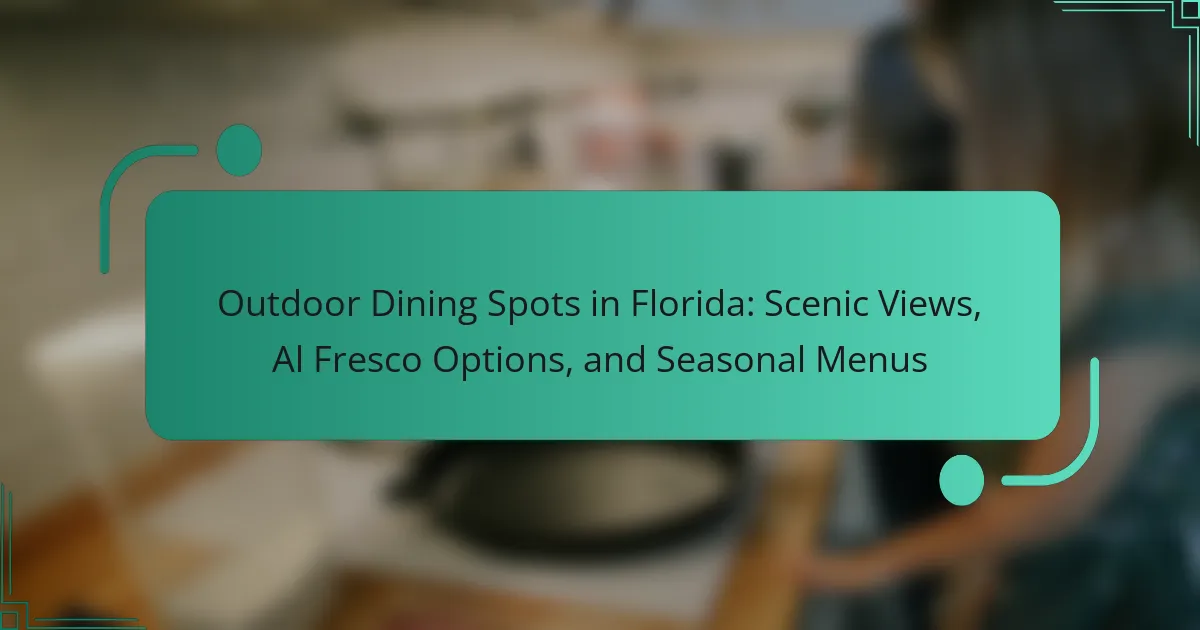Outdoor dining spots in Florida include restaurants and cafes that provide outdoor seating, allowing diners to enjoy scenic views and a pleasant atmosphere year-round. These venues, often located in beachfront areas, parks, and urban rooftops, feature seasonal menus that highlight fresh, local ingredients. The warm climate of Florida enhances the appeal of Al Fresco dining, making it a popular choice for social gatherings. Seasonal menus not only improve flavor and quality but also support local agriculture and align with dietary trends. Overall, Florida’s outdoor dining experiences combine natural beauty, diverse culinary offerings, and a vibrant atmosphere.

What are Outdoor Dining Spots in Florida?
Outdoor dining spots in Florida are restaurants and cafes that offer outdoor seating. These venues provide scenic views and a pleasant atmosphere. Popular areas include beachfront locations, parks, and urban rooftops. Florida’s warm climate allows for year-round outdoor dining. Many establishments feature seasonal menus highlighting local ingredients. Examples include Key West’s waterfront eateries and Miami’s rooftop bars. These spots cater to diverse tastes and dining experiences. Outdoor dining enhances the enjoyment of Florida’s natural beauty.
How do Outdoor Dining Spots enhance the dining experience?
Outdoor dining spots enhance the dining experience by providing a unique ambiance and connection to nature. Patrons enjoy scenic views that elevate the meal’s enjoyment. Fresh air contributes to a relaxing atmosphere, promoting a sense of well-being. These spots often feature seasonal menus that highlight local ingredients, enhancing flavor and freshness. Studies show that dining outdoors can improve mood and satisfaction levels. The combination of environment and quality food creates memorable experiences. Overall, outdoor dining spots significantly enrich the overall dining experience.
What unique features define Outdoor Dining Spots in Florida?
Outdoor dining spots in Florida are characterized by scenic waterfront views, tropical landscaping, and a focus on al fresco dining experiences. Many locations offer outdoor seating with ocean or lake views, enhancing the dining atmosphere. The climate allows for year-round outdoor dining, making it a popular choice for locals and tourists alike. Seasonal menus often highlight fresh, local ingredients, reflecting Florida’s agricultural diversity. Some spots feature live music or entertainment, creating a vibrant atmosphere. Additionally, many outdoor dining venues are pet-friendly, accommodating guests with pets. These unique features collectively contribute to a distinctive dining experience in Florida.
How do scenic views contribute to the appeal of these spots?
Scenic views significantly enhance the appeal of outdoor dining spots. They create an inviting atmosphere that attracts customers. Beautiful landscapes can evoke positive emotions and elevate the dining experience. Studies show that natural scenery can reduce stress and increase relaxation. This makes customers more likely to enjoy their meals. Additionally, unique views often become a focal point for social media sharing. This can lead to increased visibility and promotion of the dining location. Scenic views also differentiate a restaurant from its competitors. They can justify higher prices and encourage repeat visits from satisfied patrons.
What types of Outdoor Dining Spots are available in Florida?
Florida offers a variety of outdoor dining spots. These include beachfront restaurants, rooftop cafes, and garden patios. Waterfront dining locations are popular in coastal cities. Many spots provide scenic views of the ocean or lakes. Some restaurants feature al fresco options with open-air seating. Others have unique themes, such as tiki bars or food trucks. Seasonal menus highlight local ingredients and fresh produce. Dining options cater to diverse cuisines, enhancing the outdoor experience.
What are the most popular outdoor dining styles?
The most popular outdoor dining styles include al fresco dining, patio dining, and rooftop dining. Al fresco dining refers to meals enjoyed in open-air settings, often with scenic views. This style is favored for its relaxed atmosphere and connection to nature. Patio dining typically occurs on a restaurant’s outdoor terrace or courtyard. It offers a cozy ambiance while still being sheltered from weather elements. Rooftop dining provides a unique experience with elevated views of the surroundings. This style is often found in urban areas and is popular for its panoramic vistas. Each of these styles enhances the dining experience by combining food with the beauty of the outdoors.
How do different regions in Florida influence dining options?
Different regions in Florida significantly influence dining options. Coastal areas prioritize seafood due to proximity to the ocean. For example, the Florida Keys are renowned for fresh fish and conch dishes. Urban centers like Miami offer diverse international cuisines reflecting the multicultural population. In contrast, rural regions focus on farm-to-table dining, emphasizing local produce. Seasonal menus often change based on regional harvests and fishing seasons. For instance, citrus fruits are prominent in winter menus across the state. Each region’s geography and culture shape its unique culinary offerings.

What makes Al Fresco Dining popular in Florida?
Al Fresco Dining is popular in Florida due to its pleasant climate and beautiful outdoor settings. The state enjoys warm weather for most of the year, making outdoor dining enjoyable. Scenic views, such as beaches and parks, enhance the dining experience. Many restaurants offer outdoor seating to attract customers. Florida’s diverse culinary scene also complements Al Fresco options. Seasonal menus featuring fresh, local ingredients appeal to diners. Additionally, social gatherings in outdoor spaces are more inviting. Overall, the combination of climate, scenery, and cuisine drives the popularity of Al Fresco Dining in Florida.
How does the climate affect Al Fresco Dining choices?
Climate significantly influences Al Fresco Dining choices. In warmer climates, outdoor dining is more popular year-round. High temperatures encourage the use of shaded areas and cooling options. Conversely, cooler climates limit outdoor dining to specific seasons. Rain can deter diners, prompting restaurants to offer covered seating. Seasonal weather patterns also dictate menu offerings. For instance, lighter meals are preferred in hot weather, while hearty dishes are favored in cooler months. Understanding climate impacts helps restaurants optimize their outdoor dining experiences.
What seasonal factors should be considered for outdoor dining?
Seasonal factors for outdoor dining include weather conditions, temperature fluctuations, and daylight hours. In Florida, summer brings high humidity and rain, impacting comfort and visibility. Winter offers cooler temperatures, which can enhance the dining experience. Spring and fall provide mild weather, ideal for al fresco dining. Additionally, seasonal events and holidays may influence customer traffic. Understanding these factors helps restaurants optimize their outdoor seating arrangements and menu offerings.
How do local events impact Al Fresco Dining experiences?
Local events significantly enhance Al Fresco dining experiences. They attract larger crowds, creating a vibrant atmosphere. This increased foot traffic can boost sales for restaurants. Events often feature live music or entertainment, enriching the dining experience. Seasonal festivals can also introduce themed menus, showcasing local ingredients. Additionally, local events foster community engagement, making dining more enjoyable. Research indicates that restaurants near event venues see a marked increase in patronage during such occasions. This dynamic interaction between events and dining creates memorable experiences for customers.
Why is the ambiance important in Outdoor Dining Spots?
The ambiance is crucial in outdoor dining spots because it enhances the overall dining experience. A well-designed ambiance creates a welcoming atmosphere that attracts customers. Elements like lighting, music, and decor contribute to the mood. Studies show that pleasant surroundings can increase customer satisfaction and encourage longer stays. For example, a survey by the National Restaurant Association found that 70% of diners consider ambiance a key factor in their dining choices. Additionally, outdoor settings with natural views can improve diners’ enjoyment and relaxation. Overall, ambiance plays a vital role in customer retention and business success in outdoor dining.
What elements create a perfect outdoor dining atmosphere?
A perfect outdoor dining atmosphere includes comfortable seating, ambient lighting, and scenic views. Comfortable seating enhances relaxation and enjoyment. Ambient lighting, such as string lights or lanterns, creates a warm and inviting environment. Scenic views, like waterfronts or gardens, add visual appeal and enrich the dining experience. Additionally, temperature control through shade or heaters ensures comfort in various weather conditions. These elements combined foster a pleasant and memorable dining experience outdoors.
How do lighting and decor play a role in outdoor dining ambiance?
Lighting and decor significantly enhance outdoor dining ambiance. Proper lighting creates a welcoming atmosphere, influencing diners’ mood and comfort levels. Warm, soft lights foster intimacy, while brighter lights can energize the space. Decor elements, such as table settings and plant arrangements, add visual appeal and personality. A well-decorated space can evoke specific themes, enhancing the dining experience. Research shows that ambiance affects customer satisfaction and return rates. For instance, a study by the Cornell University School of Hotel Administration found that atmospheric elements, including lighting and decor, directly impact diners’ perceptions and spending.

What are the benefits of Seasonal Menus in Outdoor Dining?
Seasonal menus in outdoor dining offer numerous benefits. They enhance freshness by utilizing ingredients at their peak ripeness. This often results in better flavor and quality. Seasonal menus also support local agriculture by sourcing ingredients from nearby farms. This practice can reduce carbon footprints associated with transportation. Additionally, changing menus can create excitement and anticipation for diners. They encourage customers to explore new dishes and flavors. Seasonal menus can also align with dietary trends and preferences, catering to health-conscious consumers. Overall, these menus contribute to a unique dining experience that reflects the local environment and culture.
How do Seasonal Menus enhance the dining experience?
Seasonal menus enhance the dining experience by offering fresh, high-quality ingredients that reflect the current season. This approach allows restaurants to showcase local produce, which can lead to richer flavors and more vibrant dishes. Seasonal menus often change frequently, providing diners with new and exciting options. This variety keeps the dining experience dynamic and engaging.
Additionally, seasonal menus can create a stronger connection between the diner and the local environment. By featuring ingredients that are in season, restaurants promote sustainability and support local farmers. This practice can also lead to unique culinary creations that highlight the chef’s creativity and skill. Overall, seasonal menus contribute to a memorable dining experience through freshness, variety, and a sense of place.
What ingredients are typically featured in Seasonal Menus?
Seasonal menus typically feature ingredients that are at their peak freshness during specific times of the year. Common ingredients include locally sourced vegetables such as tomatoes in summer and squash in fall. Fruits like strawberries in spring and apples in autumn are also prevalent. Herbs such as basil and cilantro are used when they are abundant. Seafood is often featured based on local catches, varying with the seasons. Meats may include game or poultry that align with seasonal availability. The focus is on ingredients that enhance flavor while reflecting the local agricultural calendar. Using seasonal ingredients supports sustainability and promotes local farmers.
How do Seasonal Menus reflect local culture and cuisine?
Seasonal menus reflect local culture and cuisine by showcasing ingredients that are native to the region and available at specific times of the year. These menus often highlight traditional dishes that have historical significance in the local community. For instance, in Florida, seasonal menus may feature seafood caught locally, such as grouper or stone crab, which are integral to the state’s culinary identity. Additionally, seasonal fruits and vegetables, like citrus and tomatoes, are commonly used to create dishes that resonate with local tastes. This practice supports local farmers and promotes sustainability by reducing the carbon footprint associated with transporting food. Furthermore, seasonal menus often celebrate local festivals or cultural events, incorporating traditional recipes that reflect the area’s heritage. This connection to local culture enhances the dining experience and fosters a sense of community among patrons.
What should diners look for in Seasonal Menus?
Diners should look for fresh, locally sourced ingredients in seasonal menus. Seasonal menus often highlight produce that is at its peak flavor and nutritional value. This ensures that diners enjoy the best taste and quality. Additionally, diners should consider the variety of dishes offered. A diverse menu can showcase different cooking styles and flavors. Diners should also pay attention to the creativity in the dishes. Innovative preparations can enhance the dining experience. Lastly, diners should seek out menus that change frequently. This indicates that the restaurant is committed to using seasonal ingredients.
How can diners identify fresh, seasonal options when dining outdoors?
Diners can identify fresh, seasonal options by observing menu descriptions and asking staff. Menus often highlight local ingredients or seasonal dishes. Diners should look for phrases like “farm-to-table” or “locally sourced.” Seasonal produce typically appears in dishes during its peak harvest time. Additionally, diners can ask servers about the origin of ingredients. Many restaurants proudly share their sourcing practices. Observing the color and vibrancy of dishes can also indicate freshness. Fresh ingredients often have a more intense flavor and appealing appearance. Seasonal options contribute to a more sustainable dining experience.
What tips can enhance the experience of enjoying Seasonal Menus outdoors?
To enhance the experience of enjoying seasonal menus outdoors, choose a comfortable setting with adequate seating. Select locations that offer scenic views to elevate the dining atmosphere. Ensure proper lighting is available for evening meals, as it adds to the ambiance. Consider the weather conditions; a pleasant day improves enjoyment. Pair seasonal dishes with appropriate beverages for a cohesive dining experience. Engage in conversation with dining companions to enhance the social aspect. Use tableware that complements the outdoor environment, adding to the aesthetic. Lastly, consider timing your meal to coincide with sunset for a picturesque dining backdrop.
Outdoor dining spots in Florida are restaurants and cafes that provide outdoor seating with scenic views, enhancing the dining experience. The article explores how these venues, influenced by Florida’s warm climate, offer diverse dining options such as beachfront restaurants, rooftop cafes, and seasonal menus that highlight local ingredients. Key features include the ambiance created by scenic views, lighting, and decor, which significantly impact customer satisfaction. Additionally, the article discusses the benefits of seasonal menus and how they reflect local culture and cuisine, ultimately enriching the outdoor dining experience.


